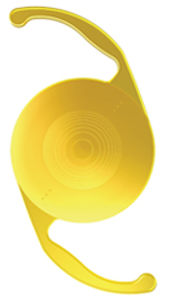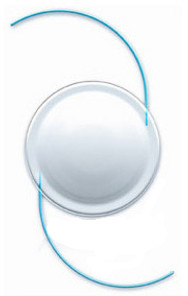

MULTIFOCAL IOL DESIGN

-
Monofocal IOLs correct a patient only at distance, where the near vision can only be corrected using positive powered spectacles
-
Multifocal intraocular lenses (MIOLs)
-
Focus both distance and near images simultaneously
-
They attempt to solve the problem of accommodation in pseudophakic patients, without the use of spectacles
-
These lenses provide at least two different foci on the same axis within the eye, as the IOLs have at least two dioptres of power
-
-
Intention is to provide:
-
A full distance visual acuity
-
Increased depth of focus
-
Sufficient near vision acuity
-
-
However, there has been controversy over the quality of vision provided by MIOLs
-
Monovision is an alternate approach where the focus of one monofocal IOL in one eye is set for distance and the other for near.
-
This design offers some patients with satisfactory vision at both distances
-
Other patients have found monovision is unacceptable as it rovides only partial binocularity
-
This has led to stereopsis loss in some cases
-
-
DIFFRACTIVE IOLS
-
Multifocal IOLs adopt the ‘diffraction principle’ where light slows down and changes direction at an edge
-
With these lenses, light is diffracted on the posterior surface, where light particles are directed to distance and near focal points
-
Therefore, providing vision at both distances
-
-
Diffractive multifocal IOLs have a design based on the Huygens- Fresnel principle to reduce lens thickness
-
Here, the lens possesses diffractive zones (concentric rings) across its posterior surface
-
Light is diffracted at each step and is focused onto two different focal points; one for distance and the other for near
-
As the pupil aperture increases, further light is focused to the distance
-
The maximum amount of light that is diffracted is 50%
-
This value can lessen as the height or number of rings is reduced
-
-
REFRACTIVE IOLS
-
Designed to direct light at varying focal points with the use of concentric zones of different powers These zones exist in the IOLs optic
-
The central region is used for distance and the peripheral for near
-
As the size of the pupil changes, different regions are used
-
Therefore, the amount of light focused on the distance and near focal points also change
-
Image quality depends on differing pupil sizes
-
Hence, is pupil dependent
-
-
-
However, these focal points occur on the same axis, thus creating two superimposed retinal images
How effective are MIOLs?
-
Vision improves after implantation of multifocal IOLs for most patients
-
A slight reduction in visual acuity and contrast sensitivity can be expected
-
-
With MIOLs, good centration and the absence of tilt are vital
-
This is to prevent astigmatism caused by the implantation
-
-
Diffractive IOLs:
-
Effective in ensuring distance and near visual performance
-
However, the dispersion of light caused unwanted symptoms:
-
Glare
-
Haloes
-
Contrast sensitivity reduction
-
-
-
MIOLs cause an increase in spherical aberration
-
This is as a result of the disruption of balance between the cornea and lens
-
Therefore the retinal image quality and vision decreases
-
-
-
The distribution of light through different focal points causes images to be unfocused, causing image confusion, especially at low contrast
ACRYSOF IQ RESTOR MULTIFOCAL IOL (ALCON)
-
Designed to provide a wide range of vision
(distance, intermediate and near), without
compromising visual performance.
-
This is due to apodisation:
-
Where the height of the diffractive steps
-
decrease with increasing eccentricity in the IOL
-
Hence, providing a smooth transition
-
With the ReSTOR lens, the diffractive region exists within the optic, but the peripheral region has refractive properties which focuses light towards the focal point for distance
-
This allows more light, as the pupil dilates, directed to the distant focal point, especially under low light levels
-
TECNIS MULTIFOCAL IOL (AMO)
-
Diffractive design only
-
Provides an advanced image quality at all distances
-
The asphericity of the lens optic, similar to that of a young crystalline lens, helps to improve the vision
-
This allows a sharp focus at both distance and near focal points
-
Corrects corneal spherical aberration.
-
However, depth of focus is reduced
-
REZOOM MULTIFOCAL IOL
-
Zonal-progressive refractive IOL
-
Possesses a range of continual focal points
-
This enables a controlled transition from distance to intermediate to near
-
-
The previous forerunner, Array MIOL caused minor visual irregularities such as haloes and glare
-
In 2005: ReZoom was introduced
-
Provided an improved visual experience, due to the decreased incidence of haloes induced
-





